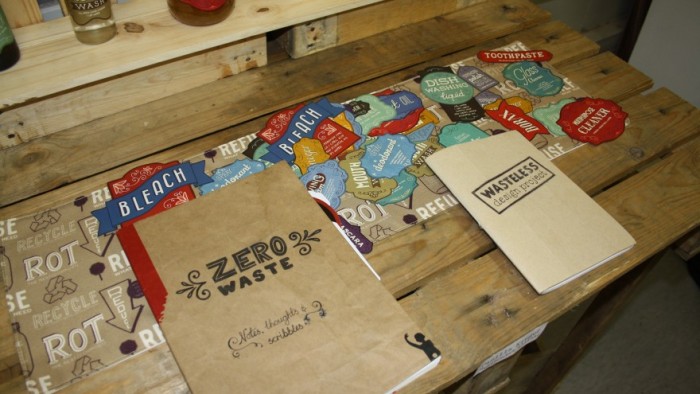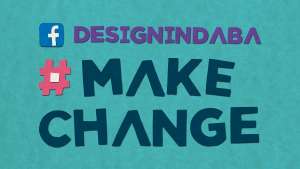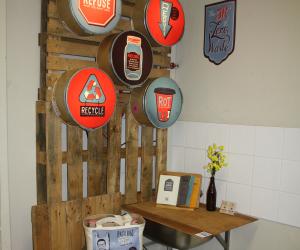From the Series

Labelled a “greenie” by her friends and family, Camilla Kruger is a Durban-based graphic designer whose life and work is dedicated to solving the tough environmental issues the world faces.
In the final year of her recently completed BTech degree at the Durban University of Technology, she focussed on her "harnessing design to promote a zero waste lifestyle" project. She produced a creative campaign that highlighting the 5Rs of zero waste and created her own zero waste recipe book.
Kruger will be part of the 2015 Emerging Creatives programme at Design Indaba Expo.
When did you first discover you wanted a career in design?
I always knew I wanted to be involved in the art world in some way or another. In pre-school I had wanted to be an art teacher, but in high school I discovered the world of design and fell in love with it and knew it was what I wanted to do.
What is your main inspiration as a designer?
Many things inspire me and I would love to say that my main inspiration comes from the natural world and my surroundings. However, “my surroundings” are my desk and my computer, so my inspiration is primarily found through my Facebook newsfeed, Pinterest, multiple design newsletters and inspiring YouTube or Vimeo videos (cat videos included).
Tell us how you mesh together digital design and handcrafted elements?
To get away from always using and relying on my computer, I enjoy drawing out type or illustration instead of simply using a font or the pen tool. I then use these elements and put my designs together digitally. I do edit my drawings where needed, but I try to keep a looseness or roughness to them as I don’t want to lose the hand-drawn look and feel. I love working on a computer but there’s just something magical about working with your hands and crafting something off-screen.
Are there recurring themes in your design work? If so, what are they and why?
I don’t intentionally have a recurring theme but I suppose my work often lends itself to an environmental theme in some shape or form. I think this is due to my personal outlook on life. However, after completing my BTech project on Zero Waste, I might ensure that I do have more of an environmental theme in my work.
How important are environmental issues in your work? Can you give us an example of how this plays out in your designs?
In the case of my Zero Waste project, it was a very crucial element and one that I do wish to continue in my work. My designs for this project all offer various ways to help people live a Zero Waste life which ultimately would reduce the amount of waste produced and, in turn, reduce the amount of waste sent to landfills.
Tell us how you use design to make the world a better place?
During my BTech research, I came across two quotes which hit me hard as a designer: "Designers make the world's most beautiful trash" and “One fifth of the mass of municipal solid waste in the US today is good packaging.”
When considering that my designs, or any other designer’s for that matter, are possibly going to end up in landfills one day, it totally changed my perspective on things. I’d love to come up with more practical solutions to solve part of our environmental issues. I believe we should all be doing our bit to solve these problems, and design is a great way to create awareness around such issues.
Tell us a bit about your creative campaign that highlighted the 5Rs of Zero Waste?
The 5Rs are the key elements of Zero Waste and highlight the dos and don’ts of living such a lifestyle. The 5Rs are as follows: Refuse what you do not need; Reduce what you do need; Reuse what you consume; Recycle what you cannot Refuse, Reduce or Reuse; and Rot (compost) the rest. The basic concept behind this lifestyle is to own only what you need. Anything wasteful, like plastic straws or sugar sachets are a no-no, and always re-use things like material napkins or glass jars.
Tell us about the creation of your Zero Waste recipe book?
This book came about when I realised that part of living a Zero Waste life meant making your own household products. The reason behind this is that many products are made using similar ingredients and buying certain ingredients in bulk and making your own products can spare a fair amount of packaging – ultimately producing less waste. I was intrigued by this concept and wanted to see how easy it would be to make my own products and how affordable it would be in comparison to other products on the market. Overall, I wanted to share my findings with those who’d be interested and hence the recipe book was born.
How do you define a South African design aesthetic?
To me, a South African design aesthetic is bright and funky and has a rough and earthy character. When I think of South African aesthetics, I think of the hair salon tents on the side of our roads and our hand-painted signage dotted on shop fronts. It’s handcrafted, vibrant and always inspiring!
What do you hope your work achieves?
I never wanted this work to achieve anything really. If someone else could find out about Zero Waste through this, that’d be great, but ultimately this project was for my own self-discovery and research into the way I’d like to live out my life.
Tell us a bit about your creative process: how you go from conception to final product?
The first thing I do is think and ponder over what’s important within the area I’m focusing on and I’ll do a bit of research into that area. Once I think I have a few good concepts in mind, I then brainstorm further and draw out multiple scamps, research further and make notes. Once I’ve developed my ideas enough, I neatly draw what I want to be hand- drawn before I scan everything in. My work up until now is predominantly black and white, so now it’s time to add some colour into the mix!
Do you have a favourite design? If so, which one and why?
At the moment my favourite design is Nikki Kreis’s “Peg-it-all Pegboards” which just screams simplicity. I love its functionality and the idea that you can customise your own space again and again!
What do you believe the biggest benefit of design is?
This is a difficult question to answer, as there are so many benefits. However, if I had to pick one, it would be how design can simplify the most complex things and allow people to understand complexities. The longer answer to this question lies within Do Good Design by D.B. Berman. An excellent read for every designer, plus it’s a thin book!
What are you currently working on?
My next endeavour, which may span over a few years, is to build a tiny house. This is essentially a house on a trailer that is approximately 15m², and I plan to build it so that it runs completely off-grid.
What has been your best memory/greatest achievement so far?
Being selected as an Emerging Creative is most definitely the greatest achievement and honour that I’ve had so far in my career as a designer.
Why did you apply to be part of the Emerging Creatives programme?
After completing BTech, our lecturer advised all BTech students to enter and so I did. I saw it as a great opportunity and was pleasantly surprised when I was accepted.
What do you hope to get out of the programme?
I hope to learn a lot and meet and connect with a large array of designers and interesting people. It’s also a great opportunity to promote and create awareness surrounding the concept of Zero Waste.
What is it like being a designer in South Africa? What are some of the pros, cons and possibilities?
I’ve only just stepped out of university, so I have yet to experience much of the design world, but so far it seems like there is a lot of opportunity in South Africa and a bunch of amazing designers in our midst.
Do you sell your designs? If so, where?
No, I don’t. I do have my recipe book and labels available for free download on my behance portfolio.








